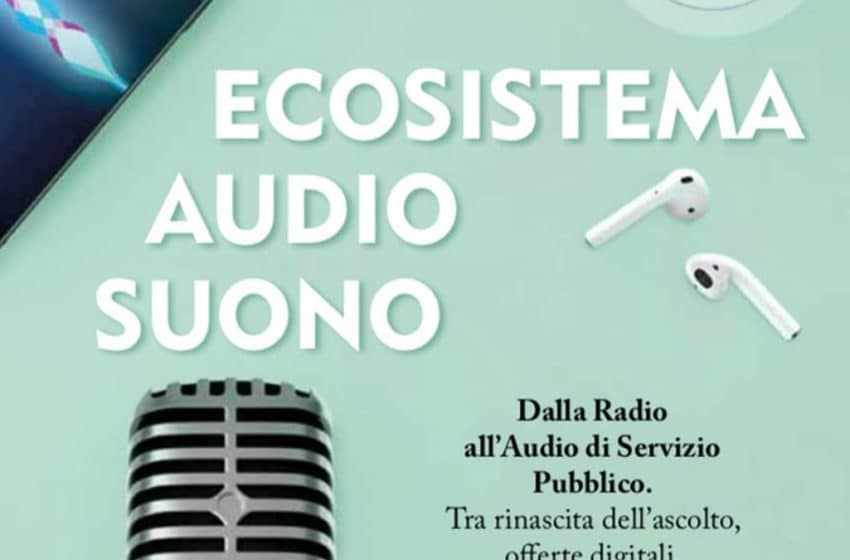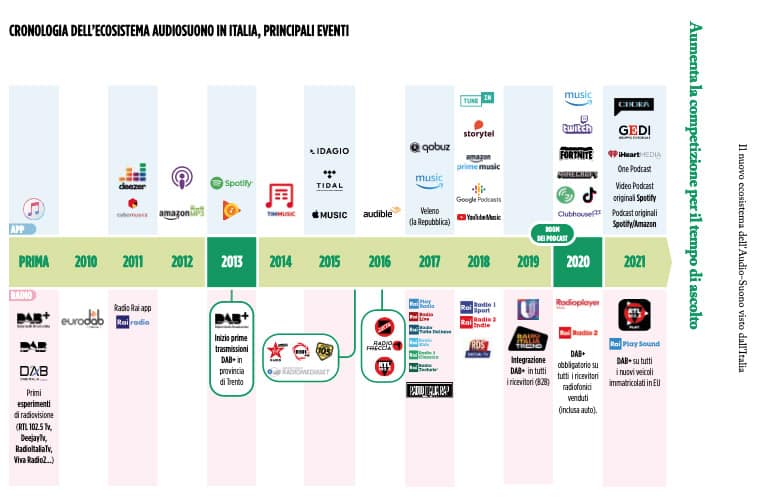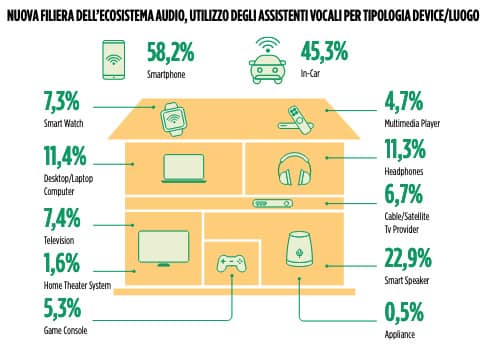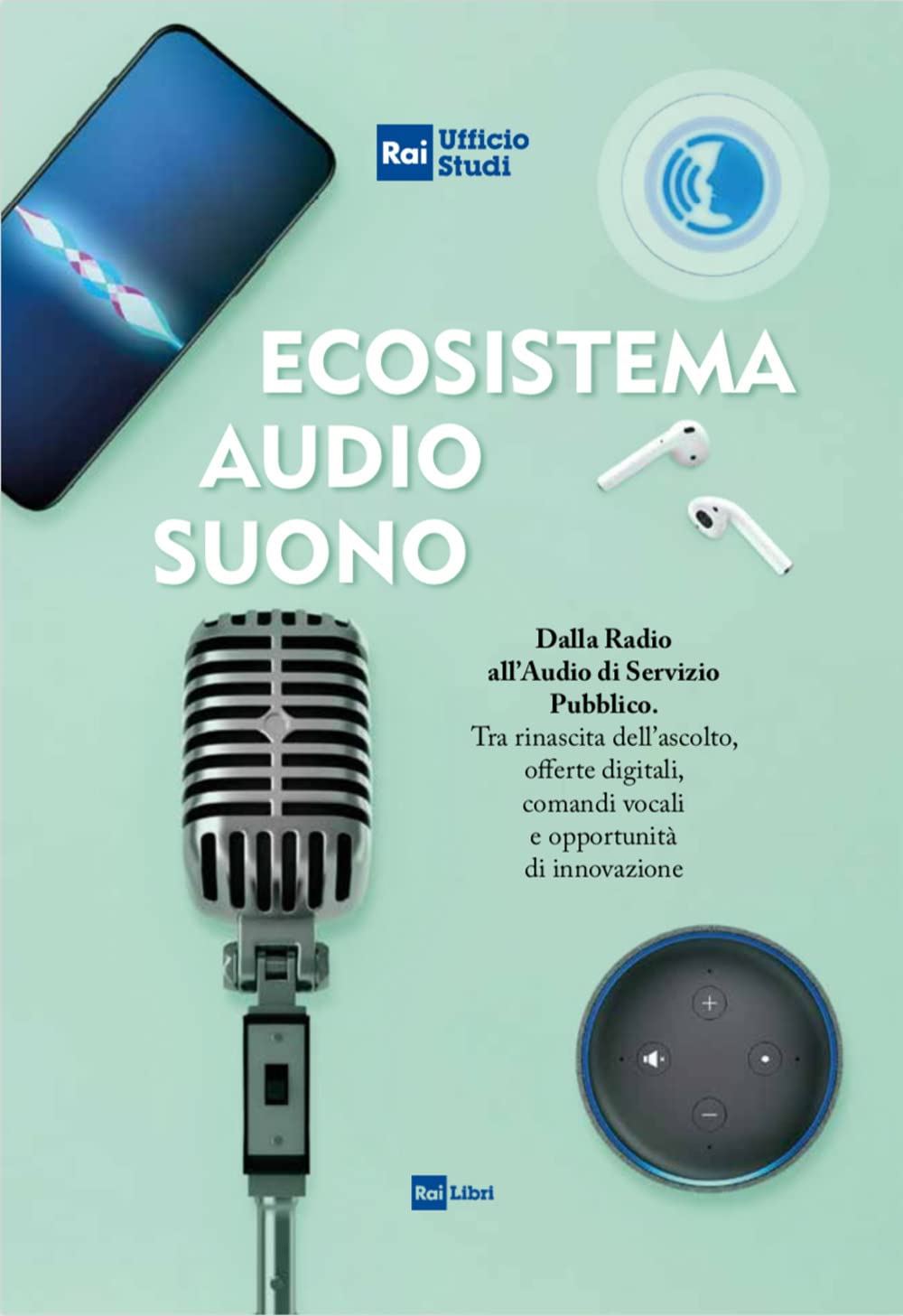
ROME — As someone more used to reflecting on the radio market through PowerPoint presentations and concise executive summaries of highly focused reports, I was a little thrown at finding 1.2 kg of radio report in my postbox. The word “concise” could scarcely apply to the recent study from Rai (Radiotelevisione Italiana), the Italian public service broadcaster. Even the title is lengthy: “Ecosistema audio-suono. Dalla radio all’audio di servizio pubblico. Tra rinascita dell’ascolto, offerte digitali, comandi vocali e opportunità di innovazione.” In English, that translates to “Audio-sound ecosystem. From radio to public service audio. Between the rebirth of listening, digital offers, voice commands and opportunities for innovation.”
Despite this, the study should enthuse future PhD students researching the history of 21st-century media. I was fortunate to receive a copy, since I had been interviewed for the report as the outgoing EBU Head of Radio. Given the poor state of electronic record storage, this study will no doubt be a rare source for understanding the transition from “radio to audio” — what the title describes as “The rebirth of listening, digital offers, voice commands and the opportunities for innovation.” Occasionally, stepping back from bite-size reports that encourage quick decision-making and taking a broader view makes perfect sense, and that exactly is what Rai has done.
The introduction of new devices and attendant innovation is accelerating at a bewildering pace. Specifically, Rai asks what the response of public media should be to this new “ecosystem” — questions that seem relevant to the whole radio/audio industry.
Examining the report
The report first looks in detail at the Italian audio market, including the adoption of devices, the presence of the tech giants, the rise of podcasting and future perspectives. It then opens the window to the wider world to examine Europe and North America, drawing together the latest research from different sources. Finally, it looks at what this may mean for the Italian public service; naturally, those challenges are not unique.
It would be impossible to review or summarize 500 pages in this article properly, so I will simply mention research that attracted my attention, using some of the graphics in the report. Figure 1 illustrates the main events in the evolution of the Italian audio ecosystem.

It shows just how quickly, in little more than a decade, Italian broadcasters are working in an environment completely unrecognizable to the previous generation — some of us can remember when the Rai had just three radio channels!
The report provides data on the increasing penetration of smart speakers, but focuses less widely on the way in which people interact with voice assistants, not just through dedicated devices. Research from Voicebot. ai demonstrates the extraordinary diversity of touch-point access in Figure 2.

Clearly, this is a fast-evolving area that the audio industry would neglect at its peril. Offering imaginative services is vital to the industry’s future success, perhaps even survival, given the increasing penetration of in-car audio.
And as if that’s not enough to keep industry strategists busy, they should reflect on media consumers’ changing lifestyle choices and possibilities in the wake of COVID. While there is a drift back to the office, the habit of boarding the 7:14 train Monday to Friday is probably consigned to history. If we look at the comparative statistics between 2019 and 2020, we see a major decline in listening in cars and places of work. Will this trend continue? And likewise, perhaps with more home-working and being tied to newer technologies, we will see a continued increase in listening using digital devices rather than dedicated radio receivers. Falling sales of radio devices suggest this is the case.
Insights from further afield
One interesting piece of research the radio industry should capitalize on comes from Canada. It asks users of streaming services what makes them switch to traditional radio services. Interestingly, people value radio when they are working or simply doing something else other than actively listening — clearly, the need to intervene and choose a particular streaming service is a distraction. Aside from that, this group of people welcomes traffic, weather and the latest news. Companionship and the human connection also score highly.
The report’s joint-editor, Paolo Morawski, reflects that the emergence of an audio industry beyond traditional terrestrial broadcast radio has been a major game changer, especially given its rate of growth and the size of many of the bigger traditional players the new entrants are up against — think David and Goliath. And it is extraordinary that these new entrants are not organizations that have historically focused on radio or even audio — their offering is just part of a broader business.
Exploiting what makes radio unique is surely the way forward. This study gives us the chance to reflect on that.
Despite this, radio has managed to hold a relatively good position, but its market share is seriously in danger unless it takes radical action to develop new services.
Looking for best practice, Morawski sees the Canadians as very important — more American than Europeans and more European than Americans. This, he believes, gives them a sweet spot within the global radio industry, which merits further study. New horizons are opening up for the industry: Gaming, artificial intelligence, the concept of the metaverse and immersive virtual reality. All of these will impact our world in some way.
Morawski sees public media as having embraced innovation effectively until now, and more so than commercial radio. Taking the longer view perhaps comes more easily to organizations that can think beyond the immediate financial pressures of remaining solvent.
In asking how the industry can respond to the changes described in the study, Morawski underlines the need for flexibility — he says it must move forward. Enriching the podcast offer and mastering the environment of the connected car will be crucial to success, both areas where the ability to form strategic partnerships will prove essential.
The realities
All this will need investment, an injection of resources usually more available to television and video. However, Morawski sees a significant source of competitive advantage in localness — being able to remain close to communities and recognizable to them. For me, this and the accessibility of services are two key areas for attention.
No one can deny that there are daily challenges for our industry. Whatever devices there may be, radio still holds a distinctive place in people’s lives. Exploiting what makes it unique is surely the way forward. This study gives us the chance to reflect on that.

Ecosistema audio-suono. Dalla radio all’audio di servizio pubblico. Tra rinascita dell’ascolto, offerte digitali, comandi vocali e opportunità di innovazione. Edited by P. Morawski and A. Zupi. (Rome, Rai Libri, 2022)
There is one significant limitation to the report: it is only published in Italian. This is not an issue for Italians or those of us who understand it. But the report deserves a broader audience. If translation is too costly, an electronic version that can be translated automatically by the reader will help communicate an important study to more of those who need to know what it says.
The author was head of Radio at the EBU until 2020, and before that managing editor of one of the BBC’s national stations. He currently advises media organizations, such as Radioplayer and the European Digital Radio Alliance.





















